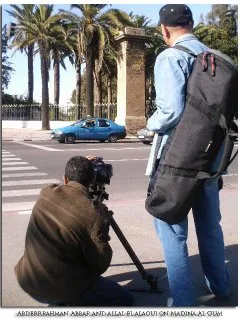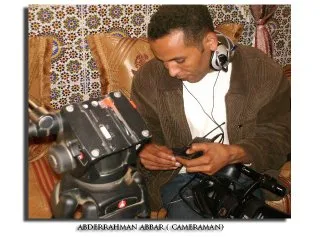
So You Want to Be aFilmmaker
•••••••••••••••••••••••••••••••••••••••••••••••••
.... Recognizing how independent films differ from studio pictures
..... Getting an overview of the filmmaking process
~ln is a powerful medium. With the right script under your arm and a r~taff of eager team players, you're about to begin an exciting ride. The
single most important thing that goes into making a successful filmmaker is
the passion to tell a story. And the best way to tell your stories is with pictures.
Filmmaking is visual storytelling in the form of shots that make up
scenes and scenes that eventually make up a complete film.
You have the power to affect people's emotions, make them see things
differently, help them discover new ideas, or just create an escape for them.
In a darkened theater, you have an audience's undivided attention. They're
yours - entertain them, move them, make them laugh, make them cry. You
can't find a more powerful medium to express yourself.
As a filmmaker, you have to decide what you enjoy doing most. Do you like
putting things together and making them happen? Then you'd probably make
a great producer. Do you like things just a certain way, can you envision things
as they should be, and do you love working with people? Then your calling
may be directing. Or do you love telling stories, and are you always jotting
down great ideas that come to you? If so, then writing screenplays may be for
you. You can be referred to as a "triple-threat" in filmmaking if you write, produce,
and direct. Having some understanding of what the other people on your
crew do - like the cinematographer, the producer, the editor, the dolly grip,
and the prop or wardrobe person - is important. Understanding what each
person on your team does will improve your working relationship with them
and, in the end, make a better film.

Digital filmmaking: The future of making films
+
Today, you can shoot your film in several different
formats. You can choose analog video or
digitalvideo or use a completely differentformat
by shooting with atraditional film camera using
super-B or 16mm film, or the choice of studio
productions, 35mm motion-picture film stock.
In this age of digital technology, almost anyone
with a computer and video camera can make a
film. You can purchase (for around $3,500) or
rent a 24-frame progressive digital camcorder
(like the Panasonic AG-DVX-l 00 - see Chapter
10 for more on cameras) that emulates the look
of motion picture film, without incurring the cost
of expensive film stock and an expensive
motion-picture camera.
If you can't afford one of these dig ita I cameras,
you can purchase computer software that takes
a harsh video image shot with an inexpensive
home camcorder and softens it to look more like
it was shot with a motion-picture film camera.
Many new computers come preloaded with
free editing software. In Ch apter 16, I give you
tips on starting your very own digital-editing
studio. You can also find out more information
on the world of digita I filmmaking in Digital
Video For Dummies by Martin Doucette (published
by Wiley). You can uncover more camera
information in Chapter 10.
High Definition (HO) TVis anew technology that
takes the video image one step farther. The picture
is much sharper, richer, and closer to what
the human eye sees as opposed to what the
video camera shows you. Watching HD video is
like looking through a window - the picture
seems to breathe. The new HDdigital cinema
cameras (the ones used by George Lucasl combine
HD technology with the 24-frame progressive
technology to emulate a unique film-like
picture quality in an electronic environment,
without the use of physical film. Unfortunately,
HD digital is still expensive (much more costly
than using a regular digital camcorder); the
cameras are extremely expensive to purchase,
and daily or weekly rental rates are usually
beyond what the independent filmmaker can
afford. HD also requires special monitors and
viewing equipmentthat processes the high resolution
in this new technology, making this
medium too complicated and expensive to be
part of the independent filmmaker's equipment.

So where do you find the good ideas to turn into films? An idea starts in your
head like a tiny seed, and then it sprouts and begins to grow, eventually blossoming
into an original screenplay. Don't have that tiny seed of an idea just
yet? Turn to Chapter 3, where you develop strategies for finding ideas or taking
a story or book and turning it into a screenplay. In that chapter, I show you
how to option (have temporary ownership of) existing material, whether it's
someone's personal story or a novel that's already been published.
You have a story in you. If something is a curiosity, is constantly on your
mind, or is troubling you, write about it. See Chapter 3 for tips on turning
your idea into a feature-length script (at least 90 pages). You'll find yourself
answering many of your own questions - you may even solve your problem.
Best of all, you could very well end up with a screenplay.
Part I: Filmmaking and Storytelling _
Surfing sites for filmmakers
+
You can find avirtually unlimited number of Web
sites dealing with filmmaking and independent
films. Becoming a filmmaker includes plugging
yourself into informative outlets that help you be
more aware of the filmmaker's world. Here I list
six sites that may be helpful to you as a lowbudget
filmmaker:
yI The Internet Movie Database (www . i mdb .
com) is avaluable information source used
by Hollywood executives. It lists the credits
of film and TV professionals and anyone
who has made any type of mark in the
entertainment industry. It's helpful for doing
research or a background check on an
actor or filmmaker.
yI The Independent Feature Project (www .
i fp . 0 rg) is an effective way to get connected
right away to the world of independent
filmmaking.
yI In Hollywood (www.inhollywood.com)
is a research site updated weekly that
offers current information on film projects.
FinancinfJ Your Film:
Where's the MonelJ?
yI The Association of Independent Video and
Filmmakers (www . ai vf . 0 rg) is an organization
that (as the name suggests) supports
ind ependent filmmakers. At the Web
site, you can find subscription information
to The Independent (a magazine geared
toward the independent filmmaker), discounts
on film-related books, festival
updates, crew classified ads, and other
membership perks.
yI IndieTalk (www.indietalk.com) is a discussion
forum forfilmmakers. Here you can
post and read messages about screenwriting,
finding distribution, financing, and lots
of other topics. It's a great site for communicating
with other independentfilmmakers.
yI Amazon.com (www.amazon.coml, an
Internet store where you can purchase
movies and books, has a plethora of information
for the inde pendent filmmaker, from
films available for sale on VHS and DVD to
cross-referencing actors, directors, producers,
and all related movie memorabilia.
+
After you've turned your idea into a completed screenplay, you can't get it
made (produced into a film) unless you have the financing. In Chapter 5, I
give you some great tips on how to find investors and how to put together a
prospectus to attract them to fund your film. You also find out about other
money-saving ideas like bartering and product placement.
In Chapter 5, I even show you how to set up your own Web site to help raise
awareness for your film, attract investors, and eventually serve as a promotional
site for your completed film. Raising money isn't as difficult as it sounds
if you have a great story and an organized business plan. You can find investors
who are looking to put their money into a film for the excitement of being involved with a film and/or the possibility of making a profit. Even friends
and family are potential investors for your film - especially if your budget is
in the low-numbers range.
On a Budi}et: Schedulini} Your Shoot
Budgeting your film is a delicate process. Oftentimes, you budget your film
first (this is usually the case with independent low-budget films) by breaking
down elements into categories - such as crew, props, equipment, and so
on - the total amount you have to spend. Your costs will be determined by
how long you'll need to shoot your film (scheduling will determine how many
shoot days you'll have), because the length of your shoot will tell you how
long you need to have people on salary, how long you'll need to rent equipment
and locations, and so on.
When you know you can only afford to pay salaries for a three-week shoot,
you then have to schedule your film so that it can be shot in three weeks.
You schedule your film's shoot by breaking down the script into separate
elements (see Chapter 4) and deciding how many scenes and shots you can
shoot each day, so that everything is completed in the three weeks you have
to work with. An independent filmmaker doesn't usually have the luxury of
scheduling the film first (breaking it down into how many days it will take to
shoot) and then seeing how much it will cost. You also should have a budget
and even a possible schedule as ammunition to show a potential investor.
Plannini} Your Shoot~ Shootini} Your Plan
Planning your film includes envisioning your shots through storyboarding,
by sketching out rough diagrams of what your shots and angles will look like
(see Chapter 9). You can storyboard your films even if you don't consider
yourself an artist. Draw stick characters or use storyboard software, like
Storyboard Quick or the 3-D Storyboard Lite, which gives you a cast of
characters along with a library of props and locations.
+
You also need to plan where you'll shoot your film. You research where
you're going to film much like planning a trip - then make all the appropriate
arrangements like figuring out how you're going to get there and the type of
accommodations if it's out of town. Regardless of where you're shooting, you'll
need to sign an agreement with the location owner to make sure you have it
reserved for your shoot dates. Also, you'll have to choose whether to film at
a reallocation, on a sound stage, or in a virtual location that you conjure up
inside your computer.
Film feeling
Audiences experien ce distinct psychological
effects when looking at film or video. Film tends
to have a nostalgic feeling, like you're watching
something that has already happened. Video
elicits the feeling that it's happening right nowunfolding
before your eyes, like the news.
Many people love old movies, not just because
of the great storytelling, but because of the sentimental
feeling they get, especially with old
black-and-white films or even the color films of
the 1960s. Steven Spielberg made Schindler's
List in black and white to help convey both the
film as a past event and the dreariness of the
war. The medium on which you set your storywhether
it be actual film celluloid on which the
images are developed, videotape, or digital with
afilm-style look- has aspecific feel and effect
on your audience.
+
Hiring Your Cast ...
Your film crew becomes your extended family (although maybe a dysfunctional
one). You spend many days and nights together - through good and
bad times - so hiring people who are passionate about your project and willing
to put their all into it is important. You may have to defer salary to your
crew if you're working on a tight budget. (Find out how to do that and more
Acting is not as difficult as you may think. People are born natural actors and
play many parts on the stage of life. Everyone is constantly in front of an
audience - or performing monologues when alone. In Chapter 8, I lead you
step by step through the process of finding a great cast to bring your screenplay
to life. I also fill you in on acting secrets so that you can direct your
actors and get the best performances.
FitminfJ in the RifJht Direction
Making a film requires special equipment, like cranes (tall apparatuses on
which you place the camera for high shots), dollies (which are like giant skateboards
that you put the camera on for movement), camera systems, and so
on. Without the proper lighting, you'll leave your actors in the darkliterally.
Lighting can set a mood and enhance the entire look of your film.
In addition to seeing your actors, you need to be able to hear them as well.
This is where the art of sound comes in. Microphones need to be placed
close enough to the actor to get a good sound recording, but not too close
as to have the microphone creep into the shot. The skill of recording great
sound comes from the production sound mixer.
If you're taking on the task of directing, you'll become a figurehead to your
actors and crew. You'll need to know howto give your actors direction and
what it takes to bring the best performance out of them.
In terms of telling your story visually, you'll need to understand a little
about the camera. Much like driving a car, you don't need to understand how
it works, but you need to know how to drive it (your cinematographer should
be the expert with the camera and its internal operations). The camera is a
magical box that will capture images so that you can effectively and visually
tell your story to the world.
Seeint) the lit)
The eye of the camera needs adequate light to "see" a proper imagewhether
it be appropriate exposure for a film camera, or enough light to get
a proper light reading for a video camera. Chapter 11 gives you the lowdown
on lighting. Lighting can be very powerful and can affect the mood and tone
of every scene in your film. A great cinematographer combined with an efficient
gaffer (see Chapter 7) will ensure that your film has a great look.
Production sound is extremely important because your actors must be heard
correctly. Your sound mixer, who's in charge of primarily recording your
actors' dialogue on set, needs to know the right microphones and soundmixing
equipment to use, as you see in Chapter 12.
Actors takint) 'Jour direction
The director's job is to help the actors create believable performances in
front of the camera that lure the audience into your story and make them
care about your characters. Directing also involves guiding your actors to
move effectively within the confines of the camera frame. Chapter 13 guides
you in the right direction with some great secrets on how to warm up your
actors and prepare them to give their best on the set.

Threatening film
Chris Gore runs an e-mail newsletter called Film
Threat Magazine. If you're afilmmaker or want
to be afilmmaker, you need to be on this mailing
list. You'll find interesting reading including
information on film festivals, box office updates,
and brutally honest movie reviews, along with
actor and filmmaker interviews. Get more information
at www.filmthreat.com.
+
ShootinfJ throufJh the camera
Directing the camera requires some technical knowledge of how the
camera works and what each lens and filter does, which I explain in Chapter 10.
Chapter 14 addresses how to frame your shots and when to move the camera.
In that chapter, you also discover the skills that make up a successful director
and how to run a smooth, organized set.
Cut It Out!: EditinfJ Your Film
Editing your film gives you a chance to step back and look at the sequence of
events and all the available shot angles in order to shape and mold them into
the most effective production. You can even repair a bad film (or at least make
it better) during the editing process. Editing is the time when you'll really see
your film coming together. It's a fascinating phase of filmmaking and can be
very rewarding as you watch your baby come together piece by piece.
Nonlinear editing software is now available for virtually any computer (starting
at $50), and it allows you to edit anything from a home movie to a professional
theatrical-length piece (90 to 120 minutes). The technology of
nonlinear editing allows you to cut your shots together in virtually any order.
You can easily see different variations of cutting different shots together,
rearrange them, and move or delete in between scenes in a concise and easyto-
understand manner. Chapter 15 tells you what the new digital technology
makes available to you for editing your film on your desktop.
ListeninfJ to 'Jour film
At the editing stage, you add and create the audio, dialogue, sound effects,
and music as you see and "hear" in Chapter 16. Titles and credits are important,
too, and I discuss them in Chapter 18.
SimulatinfJ film with software
If you can't afford to shoot your movie on film, you can use a technology by
FilmLook (www. fi 1ml oak. com). FilmLook runs your video footage through
special processors, electronic settings, and so on, and creates the effect that
your image was shot on film.
Software programs can also make your video footage look more like film.
These programs emulate grain, softness, subtle flutter, and so on. Bullet software
available at www. redgi antsoftwa re. com can convert your harsh video
footage to look like it was shot on film. The video-to-film process converts 30frame
video to a 24-frame pulldown, adding elements to create the illusion
that your images were photographed on film as opposed to shot on video.
Using software that makes your video footage look like film takes time for the
computer to process. Depending on what software you use, the processing
time could take hours or days just to turn video footage into something that
looks more like film. With a 24-frame progressive video camera, you get the
film image immediately as you shoot. (See Chapter 10 for more information
on 24-frame progressive Video.)
DistributinfJ Your Film and
FindinfJ an Audience
The final, and probably most important, stage of making a film is distribution.
Without the proper distribution, your film may sit on a shelf and never be
experienced by an audience. Successful distribution can make the difference
between your film making $10 (the ticket your mother buys) or $100 million
at the box office. The Blair Witch Project may never have generated a dime
if it hadn't been discovered at the Sundance Film Festival by Artisan
Entertainment.
There's no business like ShowBiz Expo
+
ShowBiz Expo is one of my favorite conventions.
Four times ayear, Mind Ventures offers regional
conventions in Miami, Chicago, Los Angeles, and
New York. Thousands of people flock to the expo
to schmooze with fellow filmmakers, network,
and see the latest developments in equipment
technology (and in some cases, even experiment
with the technology, hands-on). It's like a giant
toy store forfilmmakers.
Even mediocre films have done well commercially because of successful distribution
tactics. And great films have flopped at the box office because the
distributor didn't carry out a successful distribution plan.
Here are several suggestions on how to find a distributor for your film:
~ Send out your screenplay before shooting your film and see if you can
get distribution interest based on the script.
~ Send out screening cassettes of your completed film to distributors with
the potential that one will acquire your film and distribute it.
~ Enter your finished film in film festivals like the Sundance Film Festival
(see Chapter 20) and let a distributor discover you.
~ Have a premiere screening for your film and invite distributors and
industry people to the big event.
~ Set up a publicity stunt (see Chapter 22) to attract the attention of a
distributor.
Check out Chapter 19 for more tips and secrets to finding a distributor.
+


